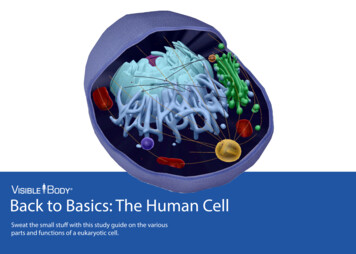
Transcription
Back to Basics: The Human CellSweat the small stuff with this study guide on the variousparts and functions of a eukaryotic cell.
There’s a great line in the 1992animated movie Fern Gully that reallyencompasses this eBook:“We’re worlds within worlds.”ImageDespite their small size (you’d need amicroscope to get a good look), cells areamazingly complex and constantly busy.Your entire body is made up of cells, allprogrammed to perform specific functions.Let’s take a look at the innerworkings of one!www.visiblebody.com2
Let’s begin with cytosol, which is a gel-like substancethat is mostly water, with various dissolved andsuspended components, like glucose, proteins, andamino acids.Cytosol is also known as intracellular fluid (ICF) and isthe fluid component of cytoplasm.Fun Fact:While it is known that cytosol is mostly water, what isn’tknown is its structure and properties within cells.www.visiblebody.com3
The plasma membrane is a flexible, semi-permeable barrier thatseparates the cell interior from its surroundings.The barrier is constructed of a phospholipid bilayer, and itscomponents allow for certain materials to pass in and out of the cell.Proteins embedded within the phospholipid bilayer carry out the specific functionsof the plasma membrane, including selective transport of molecules and cell–cellrecognition.www.visiblebody.com4
The organelles.NucleusPlasma membraneSmooth endoplasmic reticulumImageRough endoplasmic reticulumPeroxisomeLysosomeGolgi complexLipid bilayerMitochondriawww.visiblebody.com5
The nucleus is a large organelle that contains the cell’s genetic information.The nucleolus is the largest structure within a nucleus, and contains a cluster ofprotein and ribonucleic acid (RNA). It is involved with ribosome formation andthe ribosomal RNA synthesis.Fun Fact #1:Most cells have at least one nucleus, and some(like mature red blood cells) have none at all!Fun Fact #2:Nucleus is Latin for “little kernel” and its firstrecorded use in terms of cells was in 1831.www.visiblebody.comNucleolus
The endoplasmic reticulum (ER) is a network of membrane-enclosed sacs thatpackage and transport materials for cellular growth and other functions.Smooth endoplasmic reticulumRough endoplasmic reticulum
ImageSmooth ER extends from the rough ER and synthesizes lipids, steroids,and phospholipids, as well as many other metabolic processes.www.visiblebody.comImageRough ER plays an important role in the packaging and synthesisof proteins. It is “rough” due to the ribosomes that stud the ERmembrane.8
Ribosomes contain more than 50 proteins and a high concentration of ribosomalRNA. Their main function is protein synthesis; these proteins are used by the cell,the plasma membrane, or structures outside the cell.Some ribosomes float freelyin the cytosol.www.visiblebody.comSome ribosomes are boundto the ER.9
The Golgi complex consists of 3 to 20 curvedcisternae (flattened, membranous sacs),and it acts as a processing hub for proteinsproduced in the endoplasmic reticulum.Enzymes in the cisternae modify the proteinsand pack them into transfer vesicles, whichthen transport them to different areas in thecell.Golgi complexwww.visiblebody.com10
Mitochondria (sing. mitochondrion) arefamously known as the powerhouses of acell. Using the oxygen taken in by the cell,mitochondria produce ATP, a moleculeused as fuel for energy.Depending on the type of cell and itsfunction, there can be anywhere froma few hundred mitochondria to severalthousand.Fun Fact:In Madeleine L’Engle’s 1973 young adult novelA Wind in the Door, the main characters travel insidea mitochondrion named Yadah, and interact withfictional sentient structures called “farandolae.”www.visiblebody.com11
Lysosomes contain digestive enzymes that break downsubstances consumed by the cell and recycle waste.www.visiblebody.comPeroxisomes process and neutralize toxins within the cell.12
A universe of anatomical and physiologicalvisuals and reference texts at your fingertips!www.visiblebody.com
The nucleus is a large organelle that contains the cell’s genetic information. The nucleolus is the largest structure within a nucleus, and contains a cluster of protein and ribonucleic acid (RNA). It is involved with ribosome formation and the ribosomal RNA synthesis. Nucleolus Fu











